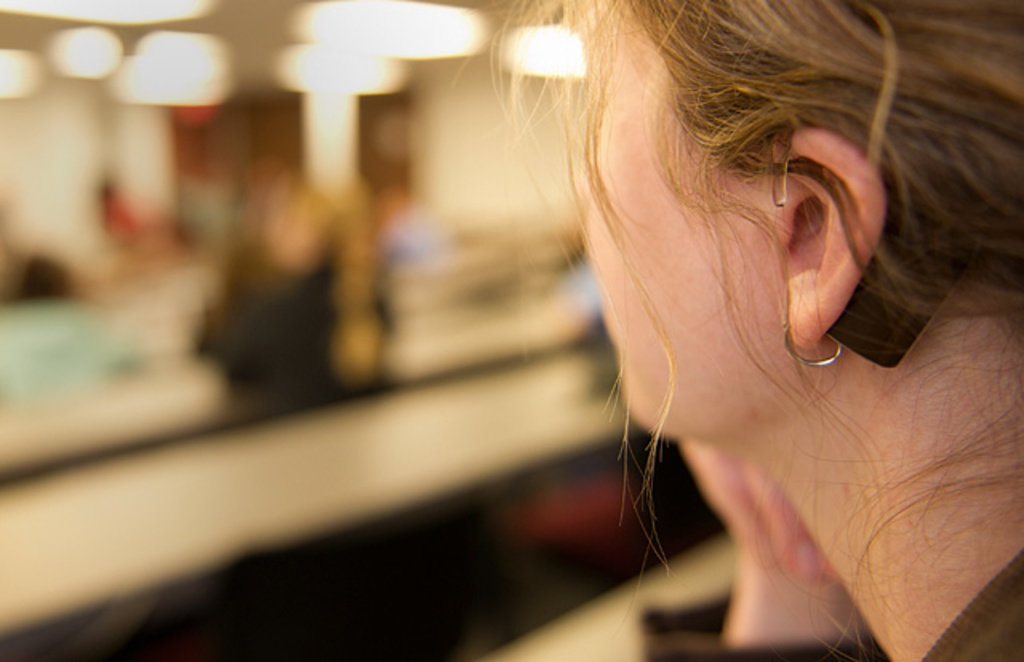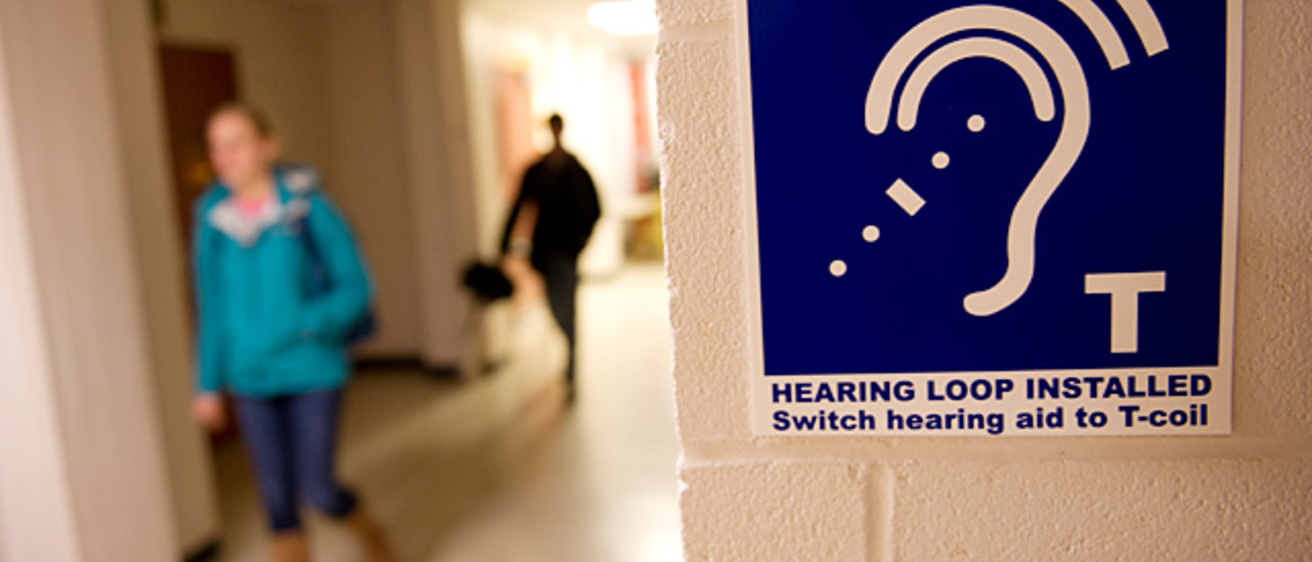Carly Armour isn’t one to shrink from challenges.
The University of Iowa disability adviser bought snowshoes her first winter in Iowa after moving from her native Georgia six years ago. Born profoundly deaf in both ears, she has also taken advantage of a wide range of assistive services and technologies, from sign-language interpreters to hearing aids and, today, cochlear implants.
But even under the best of circumstances, the experience of attending a lecture, concert, or sporting event can be less than satisfying. Distracting background noise and fluky (not to mention attention-drawing) headsets used in more common hearing assistance systems can make it hard to comprehend spoken words or enjoy music (Armour, incidentally, is a fan of Adele, P!nk, Little Big Town, and the Indigo Girls, among other artists).
Then last fall, Armour took part in a demonstration of something called a hearing loop. Unlike systems that send FM or infrared signals to headsets that users must wear over their hearing devices, the newer technology sends a signal directly to the hearing aid or cochlear implant. The clarity, Armour recalls, was unprecedented.
“I was amazed at how it sounded like the speaker was right next to me talking directly to me,” Armour says. “I’m excited for how much it’ll help others.”
So are university officials. The campus’s first hearing loop system was installed in B111 Medical Laboratories, an 84-seat lecture hall, in February and the university has plans to install systems in five other classroom, research, and performance spaces over the next several years, including the new Pappajohn Biomedical Discovery Building and Hancher.
Technology slow to catch on in United States
An estimated one in five Americans 12 years and older—about 25 million people all together—have hearing loss profound enough to affect their ability to communicate effectively. And yet the United States has been relatively slow to adopt hearing loop technology, which has been widely used in Europe for years in everything from churches and subway booths to taxi cabs.
One possible reason may be reluctance to pay for new systems when older, though less effective, systems are already in place. The Americans with Disabilities Act only requires some form of assistive listening system in assembly areas where audible communication is integral to the use of the space; it doesn’t dictate what kind.
But UI Facilities Management Accessibility Coordinator Brian Manternach says the cost of installing hearing loops—estimated to be about $20 per seat—is actually competitive with other assistive technologies and, given its likely use by more people, an economical option.
The technology is also as simple as it is effective. A room’s audio system sends a signal to an induction loop system—a stretch of copper wire embedded in a floor or ceiling—that in turn transmits magnetic energy to hearing devices fitted with telecoils (also called a t-coil or t-switch), which is to say about 85 percent of all currently manufactured devices. With the flip of a switch on the hearing aid or cochlear implant, a person’s aid becomes a tiny, personalized receiver.
“Hearing aids work best in quiet one-to-one communication situations where the speaker is about a yard away from the listener,” says Ruth Bentler, a professor with the UI Department of Communication Sciences and Disorders in the College of Liberal Arts and Sciences. “When we make the listening environment more challenging by increasing noise, reverberation, and distance, everyone has more difficulty. But the person with a hearing loss may not be able to access the speech signal.”
While later to the game than Europe, the United States is beginning to catch up. In Wisconsin, there are more than 200 looped venues throughout the state. In New York City, hearing loops are being installed in subway booths and, soon, in all taxis. One of the most ambitious states, Michigan, has hearing loops in hundreds of venues, including churches, airports, banks, funeral chapels, and even the Jack Breslin Student Events Center, home to Michigan State University’s men’s and women’s basketball programs.
‘Epiphany’ in church spurs UI alumnus to advocacy
Much of the credit for Michigan’s rapid growth in this area, and for growing awareness about the technology across the country, is given to David Myers, a social psychologist at Hope College in Holland, Mich., author of A Quiet World: Living with Hearing Loss (Yale University Press, 2000), creator of the advocacy website www.hearingloop.org and—as it turns out—a UI alumnus. In fact, Myers was a guest speaker at last October’s UI Disability Celebration, where Armour participated in the hearing loop demonstration.
Myers, who received his doctorate in psychology from Iowa in 1967, began losing his hearing as a teen because of a genetic condition that gradually eroded his ability to hear low-frequency sounds. He started using a hearing aid in his early 40s and within a few years couldn't function professionally without one. He now wears hearing aids in both ears.

He first learned about the benefits of hearing loops during a trip to Scotland’s Isle of Iona in 1999, when he stood in the stone sanctuary of an 800-year-old abbey and struggled to hear the words spoken during a religious service. The sermon was a wash of indecipherable noise as the pastor's amplified voice reverberated in the ancient vaulted space.
Myers was ready to give up when his wife noticed a blue sign with a white ear, a slash mark and a "T" in the bottom right corner—a sign he soon learned meant a hearing loop was present. Myers flipped a switch on his own hearing aid and was amazed as the pastor’s words became clear instantly.
He’s been preaching about hearing loops ever since to religious leaders, audiologists, business leaders, and anyone else who will listen. He travels throughout the country and a few years ago provided a grant—through his family foundation—to the Hearing Loss Association of America and American Academy of Audiology to support their launch of a national educational campaign called “Get in the Hearing Loop.”
“Other assistive listening systems require people to locate, check out, wear, and return a receiver-headset unit that is generally hearing aid incompatible and delivers the same generic sound to all,” says Myers. “Such equipment mostly just sits in closets, unused. A hearing loop can serve anyone in this same way, but additionally can serve the increasing majority of those with hearing technology that can receive a direct magnetic signal from the installed hearing loop.”
Myers is such a fan of hearing loops that he’s installed one in his home, where his hearing aids can tap directly into his TV, and for his office phone, which broadcasts through both hearing aids.
UI installs first loop system
The UI first began exploring hearing loop technology in 2011, when stakeholders from around campus gathered for discussions organized by Facilities Management Building & Landscape Services. Representatives from the UI Roy J. and Lucille A. Carver College of Medicine were among the participants and they soon began making plans to install the first system on campus in B111, working with a company called Hearing Loop Systems.
Jim Henderson, assistant dean for administration in the UI Carver College of Medicine, helped secure funding for the project. His interest, like Myers’, was more than just professional; he is deaf in his left ear.
“We were getting ready to do some improvements in B111, and a colleague helped me get the money,” Henderson says, estimating the installation cost at about $10,000. “We kicked the tires when the system was installed with one of our faculty members, who has bilateral hearing aids, and one with cochlear implants, and they were very happy with the results.”
Henderson says that even people like him who don’t wear hearing aids, or whose hearing devices aren’t compatible with the loop system, can benefit from wearing optional headphones.
Moving forward
The College of Medicine now has plans to install loop systems in a 75-person seminar room in the new Pappajohn Biomedical Discovery Building, which is slated for completion in 2014, as well as the Medical Alumni Auditorium in UI Hospitals and Clinics as part of renovations expected to wrap up by fall 2013.
“So we’ll have three over here, which makes me very pleased,” Henderson says.
Loop systems are also planned for three flood-related building replacement projects, including the new Art Building, School of Music, and the 1,800-seat Hancher.
“The Hancher staff is very excited to be planning a hearing loop system in our new performing arts center,” says Hancher Executive Director Chuck Swanson. “The system will have the potential to provide a significant improvement in performance sound quality for hearing aid users, plus it will be much easier for them to use than the system that we had in the original Hancher building. Our plan is to create the best possible opportunity for everyone to enjoy the performances at the new facility.”
While it’s too soon to know if any of Armour’s favorite musical groups will play in the new Hancher, you can bet she’ll be one of the first in line to buy tickets if they do.
“The hearing loop would enhance the quality of sound and make my chances of purchasing tickets triple-fold,” she says.
